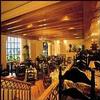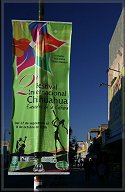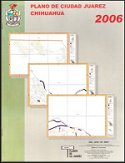Museum of Archeology - Juarez, Mexico
Located in Chamizal Park near the Cordova International Bridge The Archeology Museum has an inside exhibit which changes frequently and also a garden exhibit behind the museum building which many consider to be its chief attraction.
Inside of its main building the museum also has exhibits of art, photographs, and other objects which change every month. At the time of my visit in April, 2003, the museum was hosting an exhibit of 15 years of photographs of Mexican photographer Jorge Eugenio Navarrete.
This proud warrior is one of several that guard the thousand-year-old city of Tula, capital of the Toltec empire. The ruins of Tula were an inspiration to the later Aztec rulers. Like the other exhibits in the museum garden, this one is a reproduction of an ancient sculpture.
This Aztec jaguar now menaces children playing in the pond behind the museum. It is a very close copy of a similar sculpture in the National Museum of Anthropology in Mexico City. The jaguar represented courage and strength to the Aztecs.
This is another common Olmec sculpture motif, depicting a figure underneath an altar-like structure. These images are thought to symbolize a ruler on a throne, or humanity springing from its mother, the Earth. Sometimes, the figure under the structure is shown holding an infant.
This is a face from the beautiful Maya pyramid at Uxmal. The long, elephant-like nose indicates that this is the face of Chac, the Mayan rain god. Faces of Chac are quite common on Maya structures in the Yucatan, symbolizing the critical importance of water to this agricultural society. Facades like this were built in what archaeologists call the Early Classic Maya period, during the years 250-600 AD. This is contemporaneous with the fall of Rome and the Dark Age in Europe, and the Six Dynasties period in China.
Colossal heads like this, thought to be representations of actual rulers, were carved by the Olmec people of southern Mexico. A replica of a similar head is in the Smithsonian’s National Museum of Natural History.
Location: Parque Chamizal
Hours: 9 a.m. – 5 p.m. – Tuesday – Saturday; 11 a.m. – 5 p.m. Sunday




